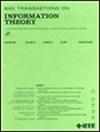Several New Classes of Self-Orthogonal Minimal Linear Codes Violating the Ashikhmin–Barg Condition
IF 2.9
3区 计算机科学
Q3 COMPUTER SCIENCE, INFORMATION SYSTEMS
引用次数: 0
Abstract
Linear codes have attracted considerable attention in coding theory and cryptography due to their significant applications in secret sharing schemes, secure two-party computation, and Galois geometries, among others. As two special subclasses of linear codes, minimal linear codes and self-orthogonal linear codes are of particular interest. Constructing linear codes that possess both minimality and self-orthogonality is very interesting. The main purpose of this paper is to construct self-orthogonal minimal linear codes that violate the Ashikhmin-Barg (AB for short) condition over the finite field违反Ashikhmin-Barg条件的几类新的自正交极小线性码
线性码由于其在秘密共享方案、安全两方计算和伽罗瓦几何等方面的重要应用,在编码理论和密码学中引起了相当大的关注。极小线性码和自正交线性码作为线性码的两个特殊子类,引起了人们的广泛关注。构造既具有极小性又具有自正交性的线性码是非常有趣的。本文的主要目的是构造有限域$\mathbb {F}_{p}$上违反Ashikhmin-Barg(简称AB)条件的自正交最小线性码。首先,我们在有限域$\mathbb {F}_{2}$上给出了违反AB条件的几类自正交最小线性码,并确定了它们的权值分布。其次,对于任意奇素数p,我们用p元函数构造两类自正交线性码,它们包含一些最优或几乎最优码。最后,基于稳定函数,构造了两类违背AB条件的自正交线性码。还提供了它们的权重分布。据我们所知,本文首次研究了违反AB条件且满足自正交的线性码的构造。
本文章由计算机程序翻译,如有差异,请以英文原文为准。
求助全文
约1分钟内获得全文
求助全文
来源期刊

IEEE Transactions on Information Theory
工程技术-工程:电子与电气
CiteScore
5.70
自引率
20.00%
发文量
514
审稿时长
12 months
期刊介绍:
The IEEE Transactions on Information Theory is a journal that publishes theoretical and experimental papers concerned with the transmission, processing, and utilization of information. The boundaries of acceptable subject matter are intentionally not sharply delimited. Rather, it is hoped that as the focus of research activity changes, a flexible policy will permit this Transactions to follow suit. Current appropriate topics are best reflected by recent Tables of Contents; they are summarized in the titles of editorial areas that appear on the inside front cover.
 求助内容:
求助内容: 应助结果提醒方式:
应助结果提醒方式:


